Related Research Articles

Admiral of the Fleet Sir Frederick Charles Doveton Sturdee, 1st Baronet was a Royal Navy officer. After training as a torpedo officer, he commanded two different cruisers and then three different battleships before becoming commander of the 1st Battle Squadron of the Home Fleet. He went on to command the 3rd Cruiser Squadron and then the 2nd Cruiser Squadron.
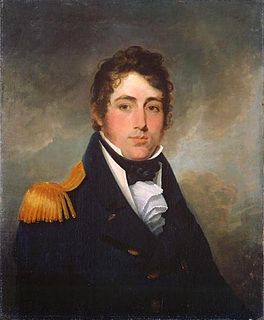
Admiral of the Fleet Sir Provo William Parry Wallis, was a Royal Navy officer. As a junior officer, following the capture of USS Chesapeake by the frigate HMS Shannon during the War of 1812, the wounding of HMS Shannon's captain and the death of her first lieutenant in the action, he served as the temporary captain of HMS Shannon as she returned to Halifax, Nova Scotia, with Chesapeake.

The North America and West Indies Station was a formation or command of the United Kingdom's Royal Navy stationed in North American waters from 1745 to 1956. The North American Station was separate from the Jamaica Station until 1830 when the two combined to form the North America and West Indies Station. It was briefly abolished in 1907 before being restored in 1915. It was renamed the America and West Indies Station in 1926. It was commanded by Commanders-in-Chief whose titles changed with the changing of the formation's name, eventually by the Commander-in-Chief, America and West Indies Station.

The Commander-in-Chief Fleet (CINCFLEET) was the admiral responsible for the operations of the ships, submarines and aircraft of the British Royal Navy from 1971 until April 2012. The post was subordinate to the First Sea Lord, the professional head of the Naval Service. In its last years, as the Navy shrank, more administrative responsibilities were added.
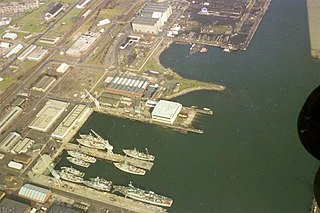
Rosyth Dockyard is a large naval dockyard on the Firth of Forth at Rosyth, Fife, Scotland, owned by Babcock Marine, which formerly undertook refitting of Royal Navy surface vessels and submarines. Before its privatisation in the 1990s it was formerly the Royal Naval Dockyard Rosyth. Its primary role now is the dismantling of decommissioned nuclear submarines. It is also the integration site for the Royal Navy's newest aircraft carriers, the Queen Elizabeth class as well as the Type 31 Frigate.

The Atlantic Fleet was a naval fleet of the Royal Navy. It existed for two separate periods; 1909 until 1914, and then 1919 until 1932.

The Commander-in-Chief, The Nore, was an operational commander of the Royal Navy. His subordinate units, establishments, and staff were sometimes informally known as the Nore Station or Nore Command. The Nore is a sandbank at the mouth of the Thames Estuary and River Medway.
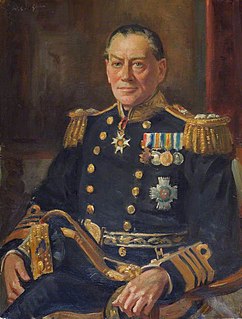
Admiral Sir Herbert William Richmond, was a prominent Royal Navy officer, described as "perhaps the most brilliant naval officer of his generation." He was also a top naval historian, known as the "British Mahan", the leader of the British Royal Navy's intellectual revolution that stressed continuing education especially in naval history as essential to the formation of naval strategy. After serving as a "gadfly" to the British Admiralty, his constructive criticisms causing him to be "denied the role in the formation of policy and the reformations of naval education which his talents warranted", he served as Vere Harmsworth Professor of Imperial and Naval History at Cambridge University from 1934 to 1936, and Master of Downing College, Cambridge from 1934 to 1946.

Admiral Sir Gerald Louis Charles Dickens was a senior Royal Navy officer and the grandson of Victorian novelist Charles Dickens.
Admiral Sir George Edwin Patey, was a senior officer in the Royal Navy.

Admiral Sir William Jock Whitworth, was a senior Royal Navy officer who served as Second Sea Lord and Chief of Naval Personnel from 1941 to 1944.
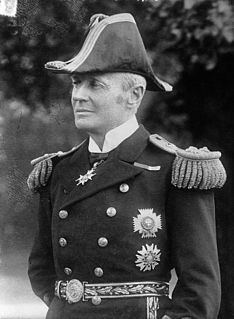
Admiral of the Fleet Sir Arthur Dalrymple Fanshawe, was a Royal Navy officer. As a captain he became commanding officer, successively, of the troopships HMS Jumna and HMS Malabar, which were tasked with ferrying troops between the United Kingdom and India. These were difficult commands with regular disputes between the military officers in charge of the troops and the naval officers in command of the ships.
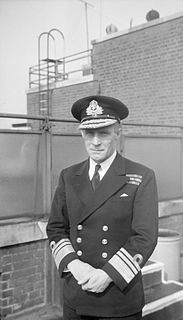
Admiral Sir Guy Charles Cecil Royle was a Royal Navy officer who went on to be Fifth Sea Lord and First Naval Member of the Royal Australian Navy.

Vice-Admiral Harold Taylor Wood Grant, was a Canadian naval officer and a post-war Chief of the Naval Staff. The son of Lieutenant Governor of Nova Scotia, MacCallum Grant, Harold Grant entered the Royal Canadian Navy as a cadet in 1914. He spent most of the First World War in training until 1917, when he became a midshipman aboard a British Royal Navy ship. Considered an above average officer, he was earmarked for early promotion during the interwar period and by 1938, commanded the destroyer HMCS Skeena.

Vice-Admiral Arthur Edward Frederick Bedford, CB, CSI was a Royal Navy officer. He served in HMS Kent at the Battle of the Falkland Islands of 1914 and rose to command the Royal Indian Navy from 1934 to 1937, when he retired. A year later he rejoined the colours and served until the end of the Second World War.
Vice-Admiral Edward Astley Astley-Rushton, CB, CMG was a senior Royal Navy officer who commanded the Reserve Fleet.

Vice-Admiral George Clarence Jones, was a Royal Canadian Navy vice admiral who served as Chief of the Naval Staff from 15 January 1944 to 28 February 1946.
Admiral Frank Finnis was a British Royal Navy admiral before the First World War.

The Assistant Chief of the Naval Staff formerly the Assistant Chief of the Naval Staff is a senior Royal Navy appointment responsible for naval aviation. The post is also the successor to the Royal Navy's Flag Officer for naval aviation in the British Isles, established since 1939.
Admiral Bertram Mordaunt Chambers, CB was a Royal Navy officer who served in Australia and Canada.
References
- ↑ "Naval & Military intelligence". The Times. No. 36054. London. 1 February 1900. p. 6.